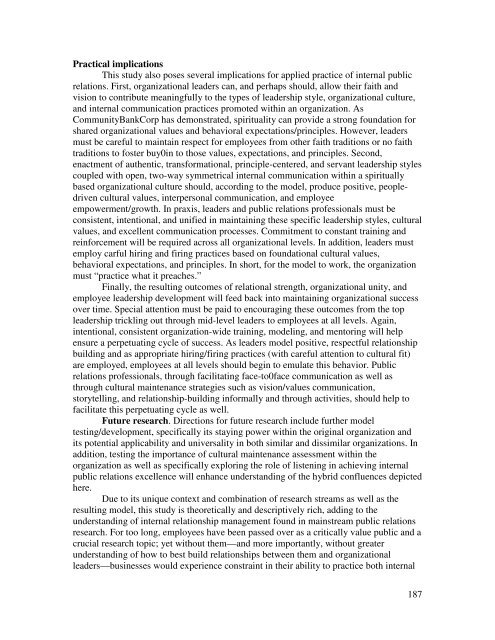2010 - Public Relations Society of America
2010 - Public Relations Society of America
2010 - Public Relations Society of America
Create successful ePaper yourself
Turn your PDF publications into a flip-book with our unique Google optimized e-Paper software.
Practical implications<br />
This study also poses several implications for applied practice <strong>of</strong> internal public<br />
relations. First, organizational leaders can, and perhaps should, allow their faith and<br />
vision to contribute meaningfully to the types <strong>of</strong> leadership style, organizational culture,<br />
and internal communication practices promoted within an organization. As<br />
CommunityBankCorp has demonstrated, spirituality can provide a strong foundation for<br />
shared organizational values and behavioral expectations/principles. However, leaders<br />
must be careful to maintain respect for employees from other faith traditions or no faith<br />
traditions to foster buy0in to those values, expectations, and principles. Second,<br />
enactment <strong>of</strong> authentic, transformational, principle-centered, and servant leadership styles<br />
coupled with open, two-way symmetrical internal communication within a spiritually<br />
based organizational culture should, according to the model, produce positive, peopledriven<br />
cultural values, interpersonal communication, and employee<br />
empowerment/growth. In praxis, leaders and public relations pr<strong>of</strong>essionals must be<br />
consistent, intentional, and unified in maintaining these specific leadership styles, cultural<br />
values, and excellent communication processes. Commitment to constant training and<br />
reinforcement will be required across all organizational levels. In addition, leaders must<br />
employ carful hiring and firing practices based on foundational cultural values,<br />
behavioral expectations, and principles. In short, for the model to work, the organization<br />
must “practice what it preaches.”<br />
Finally, the resulting outcomes <strong>of</strong> relational strength, organizational unity, and<br />
employee leadership development will feed back into maintaining organizational success<br />
over time. Special attention must be paid to encouraging these outcomes from the top<br />
leadership trickling out through mid-level leaders to employees at all levels. Again,<br />
intentional, consistent organization-wide training, modeling, and mentoring will help<br />
ensure a perpetuating cycle <strong>of</strong> success. As leaders model positive, respectful relationship<br />
building and as appropriate hiring/firing practices (with careful attention to cultural fit)<br />
are employed, employees at all levels should begin to emulate this behavior. <strong>Public</strong><br />
relations pr<strong>of</strong>essionals, through facilitating face-to0face communication as well as<br />
through cultural maintenance strategies such as vision/values communication,<br />
storytelling, and relationship-building informally and through activities, should help to<br />
facilitate this perpetuating cycle as well.<br />
Future research. Directions for future research include further model<br />
testing/development, specifically its staying power within the original organization and<br />
its potential applicability and universality in both similar and dissimilar organizations. In<br />
addition, testing the importance <strong>of</strong> cultural maintenance assessment within the<br />
organization as well as specifically exploring the role <strong>of</strong> listening in achieving internal<br />
public relations excellence will enhance understanding <strong>of</strong> the hybrid confluences depicted<br />
here.<br />
Due to its unique context and combination <strong>of</strong> research streams as well as the<br />
resulting model, this study is theoretically and descriptively rich, adding to the<br />
understanding <strong>of</strong> internal relationship management found in mainstream public relations<br />
research. For too long, employees have been passed over as a critically value public and a<br />
crucial research topic; yet without them—and more importantly, without greater<br />
understanding <strong>of</strong> how to best build relationships between them and organizational<br />
leaders—businesses would experience constraint in their ability to practice both internal<br />
187
















